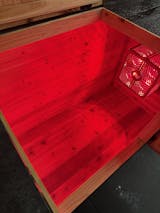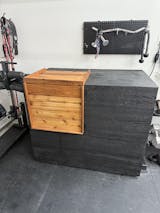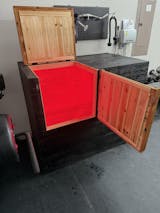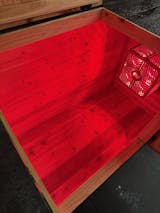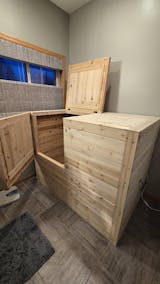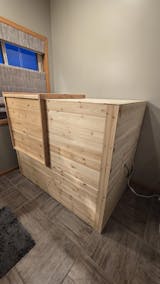How to Make Leak-Proof Threaded Connections on all of your DIY Cold Plunge Components
Building a DIY Cold Plunge is a very rewarding project, but one of the trickiest parts (for me personally) was making leak-free threaded PVC connections. Whether you’re a seasoned DIYer or just starting out, check out these tips on how I tackle threaded fittings on each plumbing component.
Why Threaded PVC Connections Matter
I very much prefer socket PVC connections, and I'd use them everywhere if I could.
Unfortunately there are a few places in a DIY Cold Plunge plumbing system that require a threaded connection – specifically the Inlet & Outlet, the Danner Pump and at the filter housing.
Threaded connections, when done incorrectly, can lead to leaks, frustration, and rework.
With the right techniques and tools, you can avoid these headaches and create a watertight setup right from the jump. Here's how I make these connections.
What You’ll Need
To get started, gather the essentials. Here's everything I cover in the video below:

-
PVC Fittings
- 3/4" Male Threaded x Socket PVC Fitting
- 3/4" Female Threaded x Socket PVC Fitting
- 1-1/2" Male Threaded x Socket PVC Elbow
- 1-1/2" Male Threaded x Socket PVC Adapter
- Inlet & Outlet Fittings
- Danner Pump - Either the 950 or 1200
- GE Whole House Filter Housing
- Thread Sealant
- Nitrile Gloves
- Paper Towels
- Q-Tips
- Pliers or Wrench
Step-by-Step Guide to Threaded PVC Connections
Check out the full tutorial showing exactly how to do this 👍
1. Prep Your Parts
-
Open your thread sealant and use the brush attached to the lid to apply it to the male threads of the components you want to connect. I don't apply any on the female threads to avoid having thread sealant build up inside the connections.
-
Spread a thin, even layer, ensuring all crevices between the threads are filled. You can use a Q-tip or paper towel to clean any excess.
2. Making Connections
Inlet & Outlet Connections
-
1-1/2" Male Threaded x Socket Adapter: Make this connection when the Inlet & Outlet fittings are already installed on your tank. You will tighten until these two fittings touch. Some thread sealant may squish out - which is just fine.
-
1-1/2" Male Threaded x Socket Elbow: This connection will be made when the Inlet & Outlet are installed on your tank. The trick here is to avoid over-tightening or reversing & turning the fitting back the other way, as this can lead to leaks. If needed, remove, reapply sealant, and try again. See the video above for a few tips on this one 👍
Pump Connections
-
For the Danner Pump, the tapered threads won’t fully butt against the pump face. These threads are tapered, so it will have more resistance the more you tighten. Hand-tighten, then add up to two rotations. Avoid over-tightening to prevent damaging the pump. This applies to both the female threads (IN port) and male threads (OUT port) on the pump. If you over-tighten and snap the pump face, you can get replacement parts here.
Filter Housing
-
The filter housing has female threads on both sides. Hand-tighten the fittings, then use a wrench for an additional 2-4 rotations. Expect more resistance with these connections than with the other parts you've used so far.
Common Mistakes to Avoid
1. Using PTFE Tape Instead of Thread Sealant
While common in plumbing projects, PTFE tape doesn’t work as effectively for these connections. It’s prone to leaks and makes fittings slippery. Slippery fittings are easy to over-tighten which can damage your parts and lead to bad connections.
2. Over-tightening
Too much force can crack fittings or damage the pump face. Tighten just enough for a secure seal. If you do break/snap something, don't sweat it. You can get replacement parts for the pump here, or reach out with any questions on how to salvage parts.
3. Forgetting the Mounting Bracket
Always attach the filter housing bracket before making connections. I've done this several times, it's super frustrating to have to redo work because you missed it.
Bonus Tips for Success
-
Plan Your Plumbing Design: A clear roadmap ensures you have all the necessary parts and prevents last-minute changes. You don't want a complicated, inefficient system or your components battling each other while it's running.
-
Test for Leaks: Before fully insulating and finishing your cold plunge, test connections with water to catch issues early.
-
Keep Learning: Check out my YouTube channel for additional tutorials, tips and tricks. There's a lot that goes into this and I am here to help.
Ready to Build Your Cold Plunge?
Threaded PVC connections don’t have to be daunting. With the right approach, you’ll save time and avoid frustrating leaks. For step-by-step plans, product recommendations, and expert advice, I've got several highly rated plans available here.
Subscribe to my YouTube Channel for more tips and tutorials, and stay tuned for my next blog post on every plumbing component you need for a cold plunge!
Reach out with any questions you have! Thanks all!
- Joe



